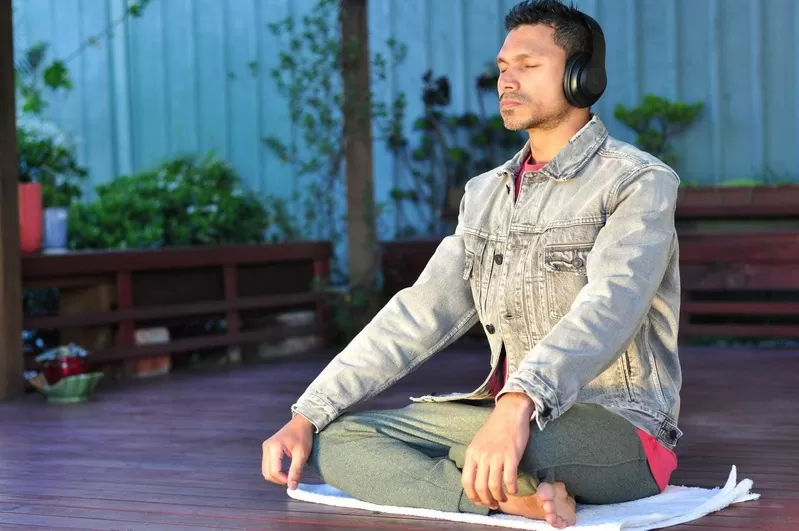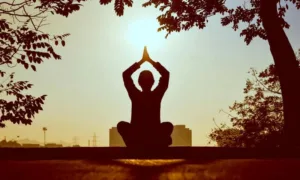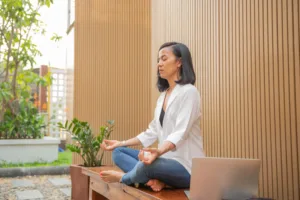Do you suffer from insomnia and always wake up in the middle of the night? Instead, do you want to have deep sleep and wake up fresh and calm? Worldwide, between 35 and 50 percent of adults report having insomnia symptoms. Insomnia is real but so is sleep meditation. You deserve to have a good night’s sleep and so this article is for you. Before delving deep into the techniques of sleep meditation, let us explain to you what sleep meditation is. Sleep meditation is a technique for calming your mind and relaxing your body before going to bed.

Meditation and Sleep
Now, you might have asked yourself how meditation improves sleep. Well, meditation can increase melatonin (the sleep hormone), increase serotonin (precursor of melatonin), slow down your heart rate, decrease blood pressure, and finally, it can activate parts of the brain that control sleep. To prove this, researchers examined how mindfulness meditation affected 49 adults with moderate sleep issues in a 2015 study published in JAMA Internal Medicine Trusted Source. The participants were randomly assigned to sleep meditation for 6 weeks. The meditation group had fewer insomnia symptoms and less daytime fatigue at the end of the study.
Are you ready to go through this journey with us? If so, place a tall glass of water and other nighttime preparations on your bedside table. Once you have settled into bed, you can start your meditation and unwind your entire body. You do not need to put up any bells and whistles for bedtime meditation; you are just taking a few minutes to connect with your feelings, thoughts, body, and perceptions. You finally fall asleep as your meditation comes to an end, spending the rest of the night allowing your body to recuperate.
You get out of bed with fresh insights, fresh goals, and a physique that can help you get through it all. Be gentle with yourself as you experiment with meditation for sleep. Just like anything else, meditation requires practice. Spend three to five minutes in meditation before going to sleep. Increase the duration to 15 to 20 minutes gradually over time. It will take time to learn how to quiet your mind. So, let us begin!
Visualization Meditation
Visualization is a popular sleep meditation technique that involves imagining yourself in a relaxing environment. If you find yourself lying awake at night, fighting anxious thoughts, this technique can help. You can find below the steps for better visualization meditation.

- Find a quiet, comfortable place to meditate without distractions.
- Allow your body to calm down in a relaxed, seated, or lying-down position.
- Clear your mind of all distracting thoughts and begin to visualize the object of your choice in your mind’s eye. You can also choose a mantra to guide your practice.
- Bring your attention to your breath after you have cleared your mind. Concentrate on a gentle inhalation through the nose and exhalation through the mouth.
- Then, return your attention to the imagery or mantra while maintaining the flow and pace of your breath.
- Visualize the image as you inhale. Feel the good feelings or intention of your picture or intention as you exhale.
Mindful Breathing Meditation
The idea is to simply pay attention to your breathing, its natural rhythm and flow, as well as how it feels on each inhale and exhale. Focusing on the breath is especially beneficial because it acts as an anchor; something you can return to at any time if you begin to feel stressed or carried away by negative emotions. And here are some steps to follow that would help you:
- Get rid of all distractions in your room, including your phone. Place yourself in a comfortable position.
- Concentrate on your breathing. Inhale for 10 counts, and then exhale for 10 counts. Exhale slowly for 10 counts. Repeat 5 times more.
- Inhale and tense your muscles. Exhale after a brief pause. Repeat 5 times more.
- Take note of your breathing and body. If a body part feels tense, deliberately relax it.
- When a thought arises; slowly return your attention to your breathing.
Guided Meditation
Guided meditation is when someone else walks you through each step of the meditation process. They might tell you to breathe or relax your body in a specific way. They may also ask you to visualize images or sounds. This method is also referred to as guided imagery. Now, a question has popped into your mind: “How is guided meditation done?” Well, you can follow these steps.

- Choose a recording. Dim the light on your phone or other devices where you’re listening to the guided meditation.
- Begin the recording. Lie down in bed and take slow, deep breaths.
- Pay attention to the guide’s voice. If your thoughts wander, gradually bring them back to the recording and yourself.
Body Scan Meditation
Body scan meditation involves focusing on each part of your body. The goal is to become more aware of your physical sensations, such as tension and pain. The act of concentrating promotes relaxation, which can aid with sleep. Embrace the following steps to have better sleep.
- Get rid of all distractions in your room, including your phone. Place yourself in a comfortable position.
- Close your eyes and take slow, deep breaths. Take note of your body’s weight on the bed.
- Concentrate on your face. Relax the muscles in your jaw, eyes, and face.
- Move your attention to your neck and shoulders. They should unwind.
- Continue down your body, ending with your fingers and arms. Proceed to the stomach, back, hips, legs, and feet. Take note of how each part feels.
- If your mind wanders, gradually return your attention to your body. If desired, repeat in the opposite direction, from your feet to your head.
Sound Meditation

Play some soothing sleep meditation music before you go to bed, which can effectively reduce stress and lull you to sleep. The best part is there is plenty of soothing music on YouTube or Spotify that you can choose from.
Here's a Guided Meditation for Sleep
Here is a guided meditation that will help you fall asleep in those moments when you’re lying in bed wide awake. Have a good night! Zzz…
Enjoyed this article? Share it!
Keep reading!

5 Best Types of Music for Meditation
Meditation is a profound practice that connects the mind, body, and soul. While silence can be powerful, adding music to your meditation routine can elevate

How Meditation Can Enhance Emotional Connection in Relationships
In recent years, meditation has gained widespread attention for its profound impact on personal well-being. But did you know it can also play an important

Embracing Stillness: 4 Simple Meditation Techniques for Overcoming Cravings
Cravings can be relentless, whether you’re dealing with the urge to eat unhealthy foods, the pull of an addictive substance, or even the compulsion to

Sleep Better, Live Better: Meditation for Insomnia Relief
Insomnia affects millions of people worldwide, leading to various health issues such as fatigue, irritability, and a weakened immune system. One effective method to combat

Clarity Amidst Chaos: How to Use Meditation for Concentration and Focus
Let’s talk about why meditation for concentration and focus is important. Focus is a crucial aspect of daily life that allows individuals to concentrate their

Meditation for Emotional Resilience: A How-to Guide
Meditation is a powerful tool that can help build emotional resilience. In our daily lives, we encounter various stressors and challenges that can impact our

